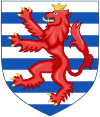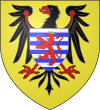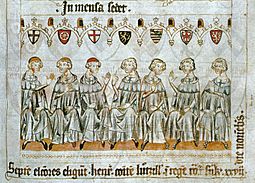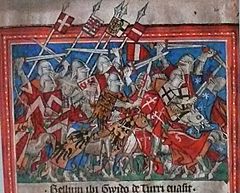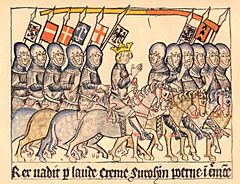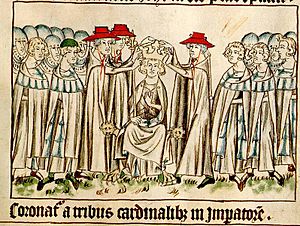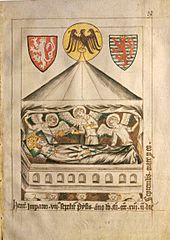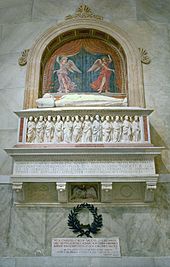Henry VII, Holy Roman Emperor facts for kids
Quick facts for kids Henry VII |
|
|---|---|
 |
|
| Holy Roman Emperor | |
| Reign | 29 June 1312 – 24 August 1313 |
| Coronation | 29 June 1312, Rome |
| Predecessor | Frederick II |
| Successor | Louis IV |
| King of the Romans | |
| Reign | 27 November 1308 – 24 August 1313 |
| Coronation | 6 January 1309, Aachen |
| Predecessor | Albert I |
| Successor | Louis IV |
| King of Italy | |
| Reign | 6 January 1311 – 24 August 1313 |
| Coronation | 6 January 1311, Milan |
| Predecessor | Conrad IV |
| Successor | Louis IV |
| Count of Luxembourg and Arlon | |
| Reign | 5 June 1288 – 24 August 1313 |
| Predecessor | Henry VI |
| Successor | John I |
| Born | c. 1273 Valenciennes, County of Hainaut |
| Died | 24 August 1313 (aged c. 40) Buonconvento, Italy |
| Burial | Duomo di Pisa, Pisa |
| Spouse | Margaret of Brabant |
| Issue | John, King of Bohemia Marie, Queen of France Beatrice, Queen of Hungary |
| House | House of Luxembourg |
| Father | Henry VI of Luxembourg |
| Mother | Beatrice d'Avesnes |
| Religion | Catholicism |
Henry VII (born around 1273 – died August 24, 1313) was a powerful ruler from the House of Luxembourg. He was the Count of Luxembourg and later became the King of Germany in 1308. In 1312, he was crowned Holy Roman Emperor. He was the first emperor after a long period without one, known as the Great Interregnum.
Henry tried to bring back the power of the empire in Italy. Italy at the time was divided by conflicts between two main groups: the Guelphs and the Ghibellines. Even though his rule was short, he was praised by famous writers like Dante Alighieri. His early death meant his plans for Italy were not fully achieved.
Contents
Becoming King: Henry VII's Election
Henry was born around 1273 in Valenciennes. His father was Count Henry VI of Luxembourg, and his mother was Beatrice d'Avesnes. He grew up in the French court. His family ruled a small area in the Holy Roman Empire where French was mostly spoken.
Because the empire was weak, Henry even became a vassal of the French King Philip the Fair. This meant he promised loyalty to the French king for protection. As Count of Luxembourg, Henry was good at keeping peace in local disputes.
Henry became important in the empire's politics after King Albert I was killed in 1308. The French King Philip wanted his brother, Charles of Valois, to be the next King of the Romans. Philip hoped the French Pope Clement V, who lived in Avignon, would support him. Philip even spent a lot of money to bribe German electors.
However, many people, including Pope Clement V, did not want France to become too powerful. Henry was a good choice because he was not strongly tied to any one country. His brother, Baldwin, Archbishop of Trier, helped convince other electors. Henry was elected King of the Romans on November 27, 1308, in Frankfurt. He was crowned in Aachen on January 6, 1309.
In July 1309, Pope Clement V approved Henry's election. The Pope agreed to crown Henry emperor in 1312. In return, Henry promised to protect the Pope and go on a Crusade after his coronation.
Before becoming emperor, Henry had to deal with issues in Germany. Some nobles in Bohemia asked Henry to help them. They were unhappy with their ruler, Henry of Carinthia. They convinced Henry to arrange a marriage for his son, John, to Elizabeth, the daughter of Wenceslas II. This gave Henry's family a claim to the Bohemian throne. In July 1310, Henry helped remove Henry of Carinthia from power.
On August 15, 1309, Henry announced his plan to travel to Rome. He sent people ahead to prepare for his army's arrival by October 1, 1310. Before leaving Germany, he made peace with the Habsburgs. They had to accept his son becoming king in Bohemia. Henry confirmed their lands in October 1309. In return, Leopold of Habsburg agreed to join Henry's trip to Italy with his soldiers.
Henry wanted to be crowned emperor by the Pope. This was important because his family was not from a very powerful background. It would also help balance the power of the French king. To make his trip to Italy successful, Henry tried to arrange a marriage. He wanted his daughter, Beatrix, to marry the son of Robert, King of Naples. This would help ease tensions between the Guelphs and Ghibellines in Italy. However, these talks failed because Robert asked for too much money, and the French king interfered.
Journey to Italy: Henry VII's Imperial Ambition
Henry began his journey into northern Italy in October 1310. His oldest son, John, stayed in Prague. As Henry crossed the Alps, many nobles and church leaders from both Guelph and Ghibelline groups came to meet him. The writer Dante hoped Henry would bring peace to Italy.
Henry wanted to bring back the glory of the Holy Roman Empire. But Italy was very divided. For many years, there had been wars between independent city-states. Each city was either Guelph or Ghibelline. Henry wanted all cities in Lombardy to welcome back their exiles. He treated both sides kindly, hoping they would do the same.
However, Henry insisted that the current rulers in Italian cities had taken power illegally. He demanded that the towns come under the empire's direct control. He also wanted exiles to return. He forced cities to agree, and their leaders had to give up their power. Henry gave them new titles, but this caused a lot of anger. He arrived in Turin in November 1310 with 5,000 soldiers.
After a short stay in Asti, Henry went to Milan. There, he was crowned King of Italy on January 6, 1311. The Tuscan Guelphs refused to attend and started preparing to fight Henry. Henry brought back the Visconti family, who had been removed from power in Milan. Guido della Torre, who had thrown out the Visconti, started a revolt against Henry. Henry quickly stopped the revolt, and the Visconti were put back in charge. Henry also put his brother-in-law, Amadeus of Savoy, in charge of Lombardy.
These actions, along with heavy taxes on Italian towns, made the Guelph cities turn against Henry. He faced more resistance when he tried to claim imperial rights over city lands and laws. Still, Henry managed to bring back some imperial power in parts of northern Italy. Cities like Parma, Lodi, Verona, and Padua accepted his rule.
Any resistance from northern Italian cities was put down harshly. Cremona was the first to face Henry's anger. After the Torriani family fled Milan, Cremona fell on April 26, 1311. Henry then destroyed the city walls. Henry spent a lot of his good will during delays, like the four-month siege of Brescia in 1311. His brother Waleran died during this siege.
People started to turn against Henry. Florence joined with Guelph cities like Lucca, Siena, and Bologna. They started spreading negative information about the king. This was successful, and Pope Clement V, under pressure from the French king, began to support the Italian Guelphs.
Despite disease and soldiers leaving, Henry forced Brescia to surrender in September 1311. Henry then went through Pavia and arrived in Genoa. There, he tried to make peace between the fighting groups in the city. While in Genoa, his wife Margaret of Brabant died.
In Genoa, Henry also learned that King Robert of Naples planned to stop the empire's power in Italy. Robert became the leader of the Guelph parties. Florence, Lucca, Siena, and Perugia all supported Robert. Henry tried to scare Robert by ordering him to attend his coronation and promise loyalty for his lands. With Florence's encouragement, much of Lombardy openly rebelled against Henry in late 1311 and early 1312.
Henry's supporters captured Vicenza. He also received a friendly message from Venice. Henry started legal action against Florence, accusing the city of treason. He placed Florence under an Imperial ban in December 1311.
After two months in Genoa, Henry sailed to Pisa. The people of Pisa, who were enemies of Florence and supported the Ghibellines, welcomed him. He again tried to negotiate with Robert of Naples. Then, he decided to make an alliance with Frederick III of Sicily. This strengthened his position and put pressure on Robert. Henry left Pisa in 1312 to go to Rome for his coronation. But he found out that Pope Clement V would not crown him there.
Conflicts in Italy: Battles with Florence and Naples
Rome was in chaos as Henry approached. The Orsini family supported Robert of Naples, while the Colonna family supported Henry. There was fighting in the streets. Henry also learned that Robert's troops controlled the Castel Sant'Angelo and the Vatican area. Robert, the king of Naples, did not want the empire to regain power in Italy.
On May 7, Henry's German soldiers entered Rome. But they could not remove Robert's troops from around St. Peter's Basilica. Since the Colonna family controlled the area around the Basilica of St. John Lateran, Henry had to be crowned emperor there. The ceremony took place on June 29, 1312. Three cardinals who supported Henry performed the coronation.
Robert of Naples made more demands on Henry. He wanted Henry to make Robert's son the imperial leader of Tuscany. He also demanded that Henry leave Rome within four days of his coronation. Henry, however, said that the emperor's power was above the Pope's. He claimed that all of Italy was under the emperor. He refused to make a truce with Robert of Naples and did not rule out attacking Robert's kingdom. After Henry made a treaty with Robert's rival, Frederick of Aragon, the chaos in Rome forced Henry to leave. He went north to Arezzo.
In Arezzo, in September 1312, Henry declared Robert of Naples a rebel. Meanwhile, Pope Clement V, who was near Avignon, did not fully support Henry. Robert was a relative of the French king, and Clement was influenced by French policies.
Before Henry could attack Robert of Naples, he had to deal with Florence. Florence had been sending money to cities that resisted Henry. They were also making their city's defenses stronger for a siege.
In mid-September, Henry approached Florence. It quickly became clear that the city's army could not defeat Henry's experienced soldiers. The Florentine army was outsmarted and lacked supplies. They retreated back into Florence during the night. Siena, Bologna, Lucca, and smaller cities sent men to help defend the walls.
The siege of Florence began. Henry had about 15,000 foot soldiers and 2,000 cavalry. Florence had 64,000 defenders. Florence managed to keep most of its gates and trade routes open. For six weeks, Henry attacked Florence's walls. He was eventually forced to give up the siege.
By the end of 1312, Henry had taken control of a large part of Tuscany. He treated his defeated enemies kindly. By March 1313, Henry was back in Pisa. From there, he formally accused Robert of Naples of treason. Robert had finally agreed to lead the Guelph League. Henry's patience was gone. He ordered that all people in rebellious cities in Italy be captured and executed for treason.
While waiting for more soldiers from Germany in Pisa, he attacked Lucca, a traditional enemy of Pisa. Henry then prepared for his next move. After taking as much money as he could from Pisa, he began his long-delayed campaign against Robert of Naples on August 8, 1313. His Italian allies did not want to join him. So, his army had about 4,000 knights. A fleet was also ready to attack Robert's kingdom directly.
His first target was the Guelph city of Siena. He began to besiege it. But within a week, Henry became very ill with malaria. He quickly grew weaker. He left Siena on August 22 and died on August 24, 1313, in the small town of Buonconvento near Siena. He was only 40 years old. His body was taken to Pisa. The hopes for a strong imperial power in Italy died with him.
Henry VII's Legacy
After Henry's death, Robert of Naples remained a central figure in Italian politics. In the empire, Henry's son, John the Blind, became King of Bohemia in 1310.
After Henry VII died, two rivals claimed the crown. They were Ludwig of Bavaria and Frederick the Handsome of the House of Habsburg. Their conflict ended at the Battle of Mühldorf in 1322, which Frederick lost. Louis's trip to Italy (1327–29) also failed. Henry's impact was most clear in the success of two local rulers he appointed in northern cities: Cangrande I della Scala of Verona and Matteo Visconti of Milan.
Henry VII's Tomb
Pisa was a Ghibelline city. This means the city supported the Holy Roman Emperor. When Henry VII died, the people of Pisa built a large tomb inside their cathedral. The tomb was placed behind the main altar. This showed how devoted the Pisans were to the Emperor.
The tomb was built in 1315 by the sculptor Tino di Camaino. It had a statue of Henry VII lying on top, along with other statues and angels. The tomb did not last long in its original form. For political reasons, it was taken apart. Its pieces were used in other places in the square.
By 1985, the Emperor's grave was moved to the right side of the cathedral. Some statues were put on the front of the cathedral. Other statues of Henry VII and his advisors were placed in the Cemetery. Today, the statues, fabrics, and gold items from the tomb are in the Museum of the Opera del Duomo in Pisa. The tomb itself remains in the cathedral.
There is also a plaster copy of the tomb from 1890 in the Victoria and Albert Museum.
Henry VII is the famous "alto Arrigo" in Dante's poem Paradiso. In the poem, Dante sees a special place waiting for Henry in Heaven. Dante describes Henry as "He who came to reform Italy before she was ready for it." Dante also mentions him many times in Purgatorio as the savior who will bring imperial rule back to Italy.
In 1921, for the 600th anniversary of Dante's death, Henry VII's tomb was opened and studied. It was opened and studied again in 2013, 700 years after his death. His remains were wrapped in a colorful silk cloth. This cloth was taken out for study and is now in the Museum of the Opera del Duomo. Scientists found that Henry VII was about 1.78 meters (5 feet 10 inches) tall. They also studied his bones to learn about medieval burial practices.
Henry VII's Family
Henry married Margaret of Brabant on July 9, 1292. They had the following children:
- John I, King of Bohemia (born August 10, 1296 – died August 26, 1346)
- Marie (born 1304 – died March 26, 1324). She married King Charles IV of France.
- Beatrix (born 1305 – died November 11, 1319). She married King Charles I of Hungary.
Images for kids
-
Henry VII and the Imperial army crossing the Alps into Italy.
-
The knights of Emperor Henry VII defeat the Guelph faction of Guido della Torre in Milan.
-
The torture and execution of the Guelph captain Teobaldo Brusati at the siege of Brescia.
See also
 In Spanish: Enrique VII del Sacro Imperio Romano Germánico para niños
In Spanish: Enrique VII del Sacro Imperio Romano Germánico para niños


